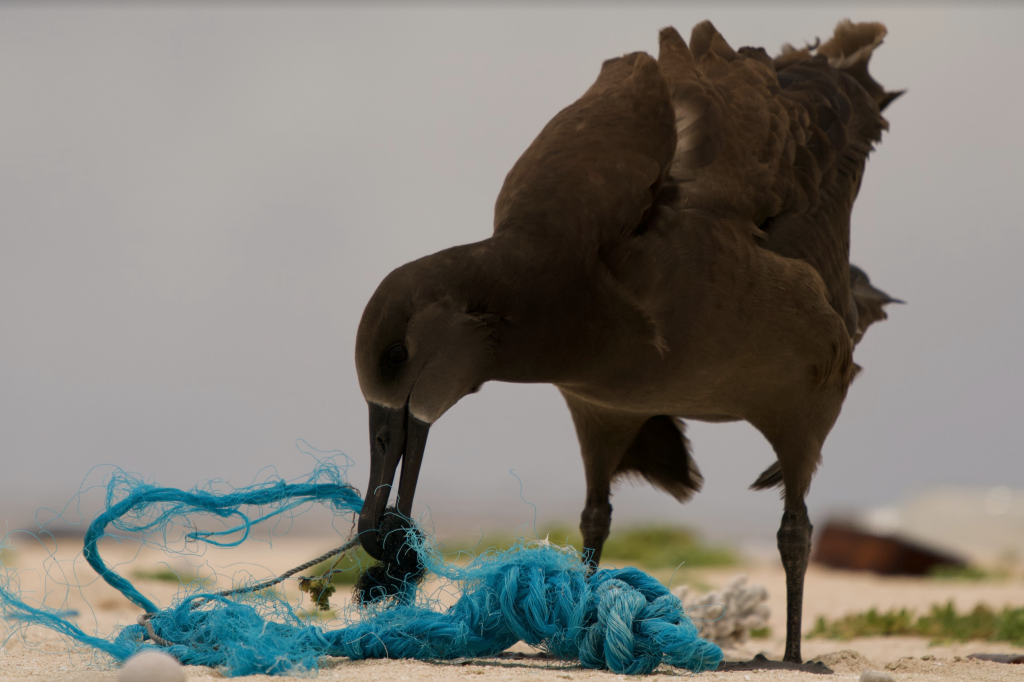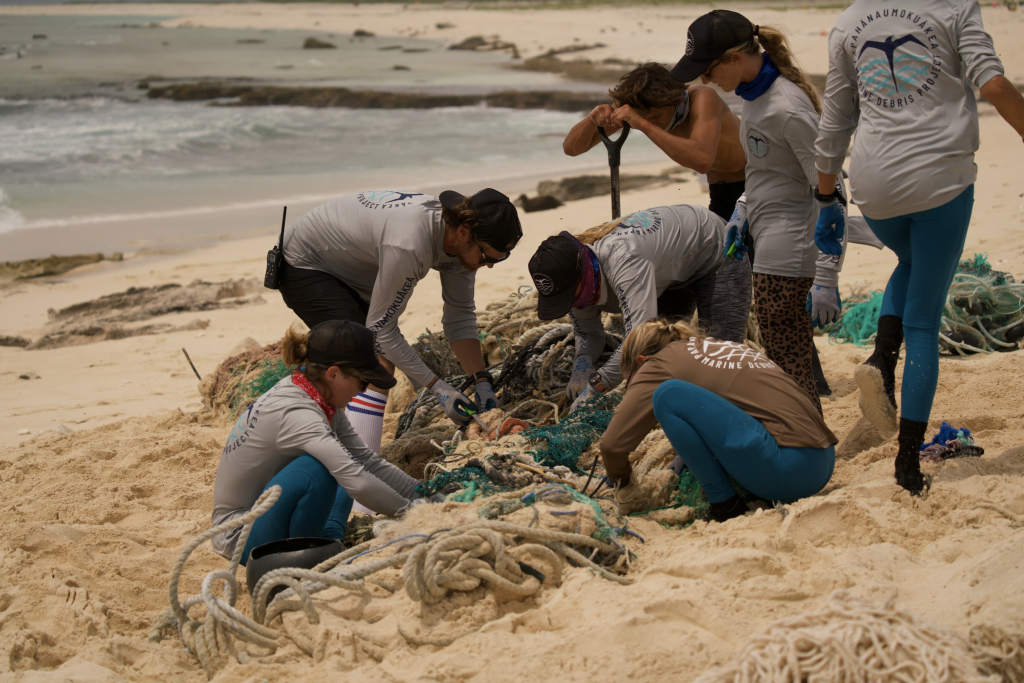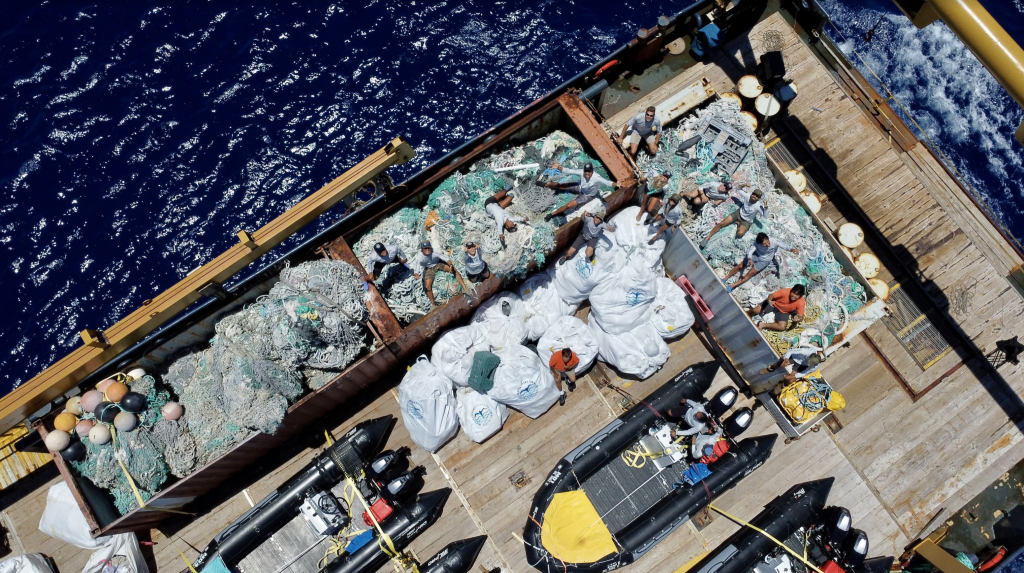86,000 pounds of ghost nets removed from single reef in Northwestern Hawaiian Islands

More than 97,000 pounds of marine debris was removed from reefs and beaches of Papahānaumokuākea Marine National Monument (Northwestern Hawaiian Islands), including 86,000 pounds of ghost nets cleaned from a single reef.
A team from the Papahānaumokuākea Marine Debris Project, a Hawaiʻi-based nonprofit organization, returned the debris to Honolulu on Saturday aboard the 185-ft ship M/V Imua.
The reef, known as Kamokuokamohoaliʻi (translation: “island of the shark god”) or Maro Reef, lies in the heart of Papahānaumokuākea Marine National Monument, a string of remote and uninhabited islands that make up the last 1,300 miles of the Hawaiian island chain.
Kamokuokamohoaliʻi itself is an open-ocean coral reef with no emergent dry land. The shallow (<10 ft depth) portion of the reef that accumulates marine debris is roughly 8 miles in length, with narrow spiderwebs of coral reefs criss-crossing a wide central lagoon.

These shallow coral gardens support a vibrant ecosystem teeming with life: endangered Hawaiian monk seals, honu (green sea turtles), rays, sharks, and thousands of reef fish, many of them found only in Hawaiʻi. Kamokukamohoaliʻi is one of the most diverse coral reefs in all of Hawaiʻi, harboring 37 coral species, according to NOAA.
Ghost nets, which are large tangled masses of lost or discarded fishing nets made of plastic, routinely snag on the shallow coral reefs of the Hawaiian islands, smothering and breaking the living coral colonies.
One single trawl net the team discovered at Kamokuokamohoaliʻi was found plastered across nearly 200 feet of reef by the ocean currents and had smothered much of the living coral underneath it. These nets also pose a major entanglement hazard for most marine wildlife, most notably the endangered Hawaiian monk seal, of which only 1,500 remain. Hawaiian green sea turtles (honu) and many species of seabirds are also vulnerable to this threat.
The team of 16 freedivers from PMDP set off from Honolulu on July 2 on a 27-day cleanup expedition to Papahānaumokuākea Marine National Monument. Over 12 intensive days of work at Kamokuokamohoaliʻi, the team surveyed 1,100 acres of coral reef and successfully removed 86,000 pounds of ghost nets from that area.

“That’s the equivalent of taking a walk through New York’s Central Park and a few surrounding blocks, and finding enough trash to equal the weight of a commercial commuter airliner,” said PMDP President Kevin O’Brien. “The fact that we are seeing this kind of accumulation in such a single small area is really indicative of the scale of the global marine debris issue. Kamokuokamohoaliʻi is one of the most pristine and isolated places on the planet, and if it’s ending up here in these quantities, it means we’ve got a problem.”
Teams of divers survey for nets by swimming search patterns over the reef. When a net is found tangled in the coral, the divers will carefully cut the net free from the reef to avoid further damage, and haul them by hand into 19-ft Zodiac inflatable boats which are launched from the mothership. Nets range in size, but can routinely weigh upwards of 2,000 pounds each. All removal work is completed using breath-hold diving techniques to keep the team quick and nimble.
“An estimated 115,000 lbs of marine debris accumulates on the reefs of Papahānaumokuākea each year, and if PMDP isnʻt cleaning it up, no one is,” PMDP Executive Director James Morioka stated. “PMDP’s next clean-up mission is in September, with the goal of removing another 100,000 lbs. Itʻs our goal at PMDP to continue regular clean-up efforts into the future to maintain coral reef health and protect countless animals from entanglement and potential injury or death.”
In addition to the 86,000 lb collected from Kamokuokamohoaliʻi, the PMDP expedition also cleaned up an additional 11,000 lb of nets and plastics from the shorelines of two other island locations: Kamole (Laysan Island) and Kapou (Lisianski Island), yielding a total haul of 97,295 lbs.

Ghost nets on the shorelines are often partially buried in the sand or tangled around tree roots, making them tough to remove. “I’ve fallen in love with Papahānaumokuākea. There is no other place like it. And it’s quite simple, when you love a place and it has woven itself into your heart, your body lunges to the work calling to be done” said Namele Naipo-Arsiga, PMDP Team Lead.
Thanks to the “Nets to Energy” partnership with Schnitzer Steel Corporation and Covanta Energy, a majority of the debris will be incinerated to generate electricity for powering hundreds of Oʻahu homes. However, before incineration, recyclable plastics will be set aside for PMDP’s local student-led ocean plastics recycling project.
This cleanup effort was made possible thanks to support and collaboration from the National Fish and Wildlife Foundation, the National Oceanic and Atmospheric Administration, Papahānaumokuākea Marine National Monument (PMNM), the US Fish and Wildlife Service Coastal Program, the McPike-Zima Foundation, and generous donations from the general public.





















